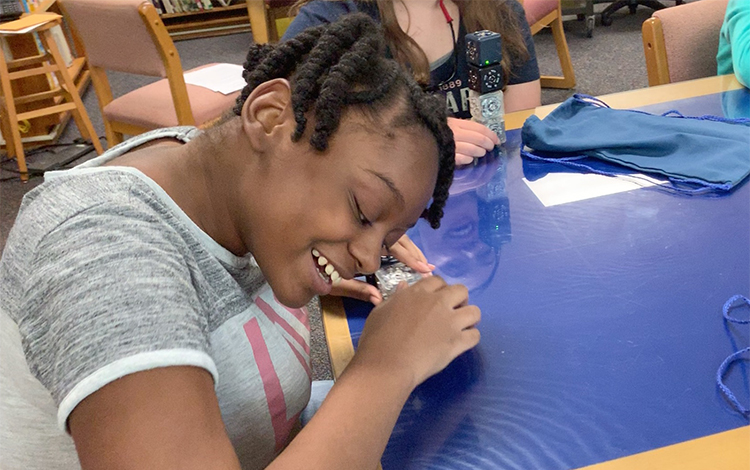The goal at Governor Morehead School in Raleigh, North Carolina is to have all students “strive for the highest levels of educational excellence and integrity in all of life’s endeavors.” As a residential school for students who are blind or have limited vision, this goal presents unique challenges to their staff. That’s why Caitlin Powell, a Residential Life Trainer at Governor Morehead School (GMS), and Janet Perez, the Instructional Technology Specialist, were so excited to find a STEAM resource like Cubelets.
“Cubelets allow our students to explore, experiment, and engage in hands-on creative problem-solving, right out of the box,” Ms. Perez says. “I haven’t even had to add tactile indicators because most of the blocks can be identified by touch.”

Cubelets are utilized at GMS in a variety of ways, most notably in the library. The robot blocks serve as vehicles for students to think outside the box and explore their creativity. Students use their tactile and sensory skills to create robots that spin, roll, and produce light. They also control the movements of their robots using Bluetooth technology.
“Each week, we introduce a new Cubelet robot that does something different,” says Ms. Powell, “For example, we may introduce a noise projecting Cubelet. We teach our students how to explore and connect the Cubelet to utilize its proper function.”
Cubelets are used either in an informal after-school makerspace setting, or in the library as part of its makerspace during school hours. Using resources from the Modular Robotics website, Ms. Perez and Ms. Powell have also created challenges for their students. For example, in one challenge, they asked the students to find how many different ways they could make three Cubelets move. When LEGO were added into the mix, Ms. Perez says, “the wow factor increased exponentially!”
Ms. Powell says that giving students the chance to figure out how each Cubelet works gets them to utilize their own personal strengths. She also notes that when a student struggles to figure out how a Cubelet works, the rest of the team will jump in to help out. These activities have not only been great for the students’ educational goals, but have also been a fun way to practice social skills.

“Our students love Cubelets,” Ms. Powell says. “[They] have created such a positive and creative space for our students to explore science and technology in a new format.”
Ms. Perez agrees. “Every student in our school, regardless of age or ability, enjoys working with Cubelets. Some of our students have cognitive challenges in addition to being blind. Seeing these students engage in meaningful STEM/STEAM activities excites me and provides a ton of professional satisfaction.”
Cubelets aren’t only for teaching science and robotics, says Ms. Powell. “They help with sensory processing, social skills, and teamwork. [Cubelets] help develop creative minds outside of the classroom.”
Ms. Perez adds that, “Cubelets help create lifelong learners. The motivation level is super high.”
She goes on to say that Cubelets are the source of the “bright spark in the eyes that every educator loves to see. The spark that says, ‘Wow, look what I just did!’”
But her favorite response to Cubelets is this: “I didn’t know I could do this!”


